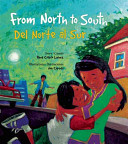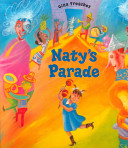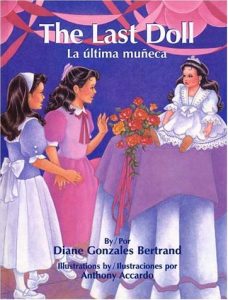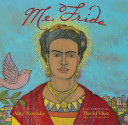 A traditional Mayan tale which reveals how the cuckoo lost her beautiful feathers.
A traditional Mayan tale which reveals how the cuckoo lost her beautiful feathers.
Mexico
Materials from Mexico
Dancing Home
A year of discoveries culminates in a performance full of surprises, as two girls find their own way to belong. Mexico may be her parents’ home, but it’s certainly not Margie’s. She has finally convinced the other kids at school she is one-hundred percent American—just like them. But when her Mexican cousin Lupe visits, the image she’s created for herself crumbles.
Things aren’t easy for Lupe, either. Mexico hadn’t felt like home since her father went North to find work. Lupe’s hope of seeing him in the United States comforts her some, but learning a new language in a new school is tough. Lupe, as much as Margie, is in need of a friend. Little by little, the girls’ individual steps find the rhythm of one shared dance, and they learn what “home” really means. In the tradition of My Name is Maria Isabel—and simultaneously published in English and in Spanish—Alma Flor Ada and her son Gabriel M. Zubizarreta offer an honest story of family, friendship, and the classic immigrant experience: becoming part of something new, while straying true to who you are.
This book has been included in WOW’s Language and Learning: Children’s and Young Adult Fiction Booklist. For our current list, visit our Booklist page under Resources in the green navigation bar.
Migrant
Migrant farmers and their families represent an ever-growing body of laborers around the world. They are used as cheap labor but most of them are not allowed to settle down, integrate into their host countries and become citizens with full rights. This is, of course, devastating to their children.
Among these groups are the Mennonites from Mexico, who originally went to Mexico from Canada in the 1920s. They speak “Low German” and though many are poor, they are an important part of the Mexican farm community. Because of free trade and the fact that Mexican farmers cannot compete with highly subsidized US farmers, they have been forced to come back to Canada — as migrant workers — in order to survive. Anna is the child of Mennonites from Mexico, who have come north to harvest fruit and vegetables. Sometimes she feels like a bird, flying north in the spring and south in the fall, sometimes like a jackrabbit in an abandoned burrow, since her family occupies an empty farmhouse near the fields, sometimes like a kitten, as she shares a bed with her sisters. But above all Anna wonders what it would be like to be a tree rooted deeply in the earth, watching the seasons come and go, instead of being like a “feather in the wind.”
From North To South/Del Norte Al Sur

José loves helping Mamá in the garden outside their home in California. But when Mamá is sent back to Mexico for not having citizenship papers, José and his Papá face an uncertain future. What will it be like to visit Mamá in Tijuana? When will she be able to come home? Award-winning children’s book author René Colato Laínez tackles the difficult and timely subject of family separation with exquisite tenderness. Joe Cepeda’s bright and engaging illustrations bring this story of hope to vivid life.
See the review at WOW Review, Volume 4, Issue 2
Naty’s Parade

Naty is excited to be dancing in the fiesta parade, until she gets lost in the city streets and cannot find the parade again.
Take Me to the River
When North Carolina fourteen-year-old Dylan Sands joins his fifteen-year-old cousin Rio in running the Rio Grande River, they face a tropical storm and a fugitive kidnapper.
The Crossing
Thirteen-year-old Manny, a street kid fighting for survival in a Mexican border town, develops a strange friendship with an emotionally disturbed American soldier who decides to help him get across the border.
The Last Doll/La última Muñeca
 The beautiful, but old-fashioned, Sarita sadly watches as her shelf-mates are purchased by eager shoppers and taken home. She looks out through the dust-covered plastic of her box, and she worries that she will be the last one. Every day she preens and puts her best porcelain face forward, but every evening, she remains on the shelf.
The beautiful, but old-fashioned, Sarita sadly watches as her shelf-mates are purchased by eager shoppers and taken home. She looks out through the dust-covered plastic of her box, and she worries that she will be the last one. Every day she preens and puts her best porcelain face forward, but every evening, she remains on the shelf.
Finally one day, a tall man in a black mustache decides that she is perfect, and that she absolutely must be the last doll for his godchild, Teresa, on her quinceañera. Sarita’s alarm at still being last quickly shifts to pride when she realizes that sometimes people save the best for last.
Nacho and Lolita
A very rare pitacoche bird falls in love with a swallow and plucks his colorful feathers to transform dry, barren San Juan Capistrano into a haven of flowers and flowing water, which the swallows can easily find when returning from their annual migration.
Me, Frida

Artist Frida Kahlo finds her own voice and style when her famous husband, Diego Rivera, is commissioned to paint a mural in San Francisco, California, in the 1930s and she finds herself exploring the city on her own.
